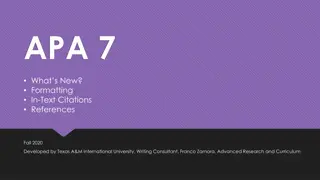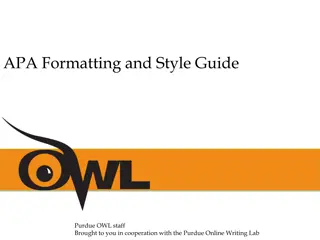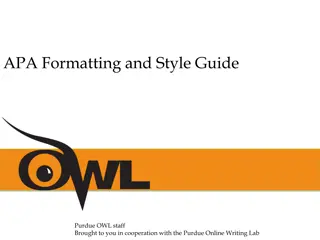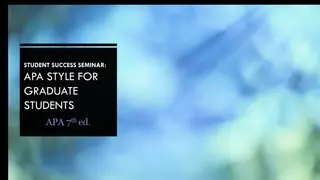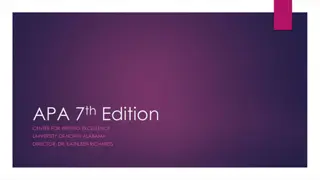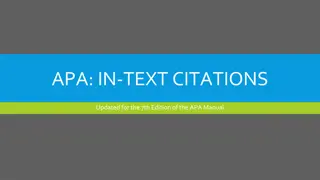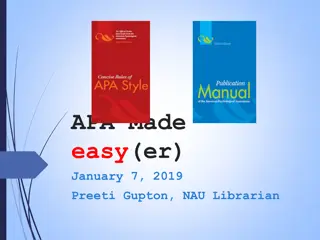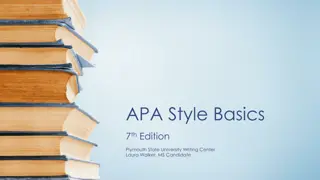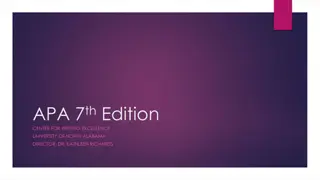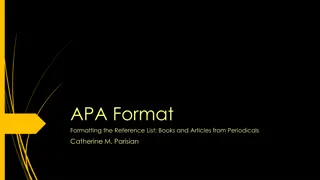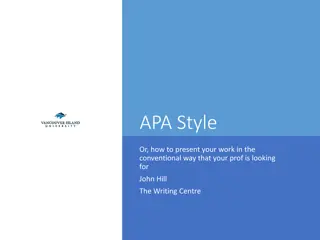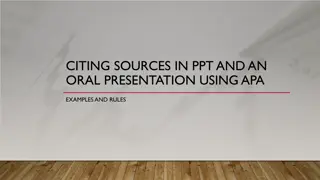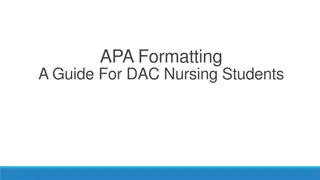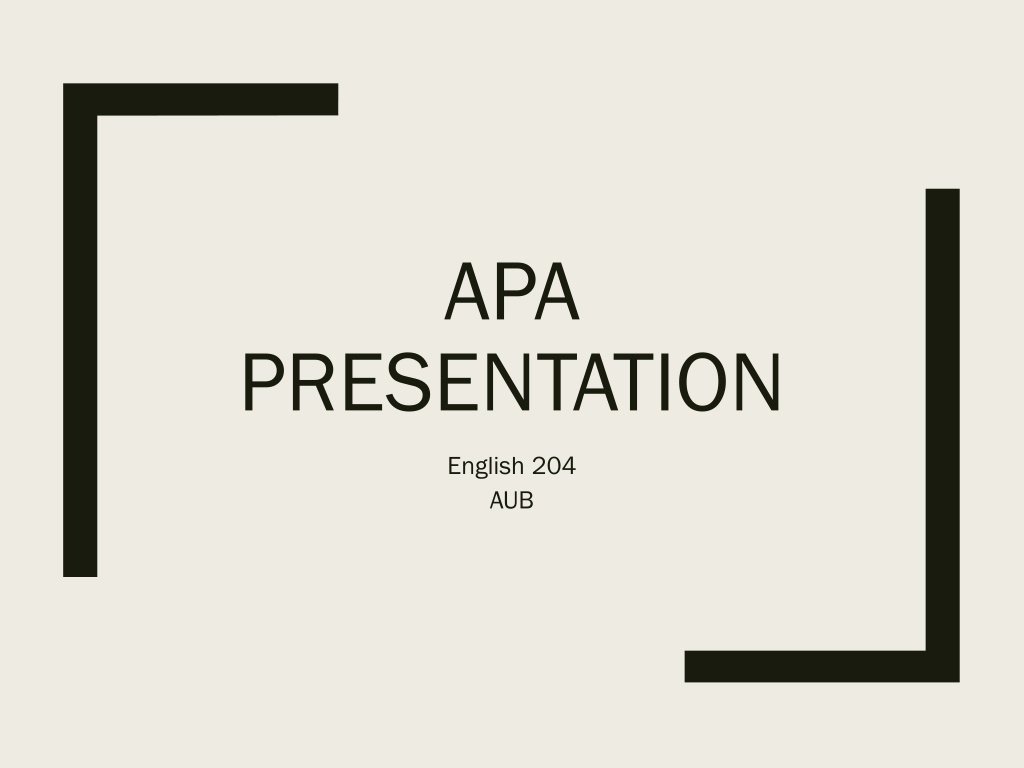
Understanding APA Citation in Scientific Research
APA (American Psychological Association) citation format is widely used in scientific research to acknowledge sources and avoid plagiarism. It includes rules for formatting papers, in-text citations, and reference lists. In-text citations can be integrated using direct quotations, paraphrases, or summaries. Knowing when to summarize or paraphrase and how to quote accurately is key to effective use of APA style.
Download Presentation

Please find below an Image/Link to download the presentation.
The content on the website is provided AS IS for your information and personal use only. It may not be sold, licensed, or shared on other websites without obtaining consent from the author. If you encounter any issues during the download, it is possible that the publisher has removed the file from their server.
You are allowed to download the files provided on this website for personal or commercial use, subject to the condition that they are used lawfully. All files are the property of their respective owners.
The content on the website is provided AS IS for your information and personal use only. It may not be sold, licensed, or shared on other websites without obtaining consent from the author.
E N D
Presentation Transcript
APA PRESENTATION English 204 AUB
What does APA stand for and in what kind of research is it used? APA stands for American Psychological Association. It is a citation format used in scientific research, and for that, it takes into consideration the year in which a work was published. LAU Writing Center - Beirut
The rules of APA determine the The rules of APA determine the following: following: Format of the paper: In-text citations Reference list LAU Writing Center - Beirut
In-Text Citations What are in What are in- -text citations? text citations? In-text citation is the integration of sources into your own writing. It is how your refer to the sources you ve used or borrowed information from so you do not plagiarize. What are the ways to integrate sources into your writing? What are the ways to integrate sources into your writing? Depending on the source and support you need, you may choose to use: Direct quotations Paraphrases Summaries LAU Writing Center - Beirut
What is the difference between these three methods? 1. 1. Summarize: Summarize: To summarize, write the main idea(s) in your own words. 2. 2. Paraphrase: Paraphrase: To paraphrase, rewrite a whole passage or section in your own words. 3. 3. Quote: Quote: To quote, include sentences or segments as they had been written in the original source. LAU Writing Center - Beirut
Whether Im summarizing or paraphrasing, I should. . . . Refer to the original source: Source last name e.g. According to Jones (1998), APA style is a difficult citation format for first- time learners. In-text citation Year of publication APA style is a difficult citation format for first-time learners (Jones, 1998, p. 199). In-text citation Note: It is not mandatory but recommended you mention the page number when you summarize or paraphrase. LAU Writing Center - Beirut
When quoting, . . . . make sure you re quoting cautiously and accurately; avoid too much quoting; and make sure you explain and interpret a quote after you mention it. LAU Writing Center - Beirut
Variations of in-text citations: Author, year, and page number at the end of the sentence Zoos must change the concept of how elephants are kept in captivity, starting with how much space we allot them (Schobert, 2005, p. 64). Author and year in the beginning of the sentence, and page number at the end of the sentence Schobert (2005) claims that zoos must change the concept of how elephants are kept in captivity, starting with how much space we allot them (p. 64). No author (citation by title, year, and page number) To alleviate the pain and suffering of elephants in zoos, [they] must change the concepts of how elephants are kept in captivity, starting with how much space we allot them (Let the Zoo s Elephants Go, 2005, p. 64). LAU Writing Center - Beirut
Citing Secondary Sources: Citing Secondary Sources: If you use a source that was cited in another source, name the original source in your signal phrase. List the secondary source in your reference list and include it in the parentheses. Add as cited in in between parentheses. Example: Original Source According to Aristotle every argument has three players: the writer, the argument itself, and the reader (as cited in Seyler, 2013, p.189 ). Secondary Source: This is the source you actually read & found the information in. This is what is found in the References page LAU Writing Center - Beirut
Integrating sources: Use reporting verbs Quote/paraphrase/summarize accurately Add interpretive statements N.B.: Try not to use verbs like says or writes to introduce your source; aim for variation and choose a verb that describes the content of the piece you are summarizing, paraphrasing, or quoting. LAU Writing Center - Beirut
Integrating sources: Examples of reporting verbs: LAU Writing Center - Beirut
The Reference List The Reference List The reference list appears at the end of the paper under a new section titled References. The word References should not be underlined, in bold or in quotation marks. The reference list must be double spaced. It is written in alphabetical order with the author s last name first. It follows hanging indentation. Only the name of the first letter of books, chapters, articles, or web pages is capitalized. Italicize the titles of books and journals. Do not italicize, underline, or put quotes around journal articles or essays. LAU Writing Center - Beirut
Referencing a book Referencing a book Author, A. A. (Year of publication). Title of work: Capital letter also for subtitle. Location: Publisher. Example: Obama, B. (2008). The audacity of hope: Thoughts on reclaiming the American dream. New York, NY: Random House. LAU Writing Center - Beirut
Referencing an article in an edited Referencing an article in an edited book book Author, A. A. (Year of publication). Title of chapter: Capital letter also for subtitle. In B. B. Author (Ed.), Title of book: Capital letter also for subtitle (pages). Location: Publisher. Example: Alibali, M.W. (2005). Mechanisms of change in the development of mathematical reasoning. In R. V. Kail (Ed.), Advances in child development and behavior (pp. 70 - 123). New York, NY: Academic press. Note Note: For "Location," you should always list the city and the state using the two letter postal abbreviation without periods (New York, NY). without periods (New York, NY). LAU Writing Center - Beirut
Referencing an article from an online Referencing an article from an online journal or periodical journal or periodical Author, A. A., Author, B. B., & Author, C. C. (Year). Title of article. Title of Periodical, volume number(issue number), pages. Retrieved from http:// Example: Scruton, R. (1996). The eclipse of listening. The New Criterion, 15(30), 5-13. Retrieved from http://www.newcriterion.com LAU Writing Center - Beirut
Referencing an article from an online Referencing an article from an online newspaper newspaper Author, A. A. (Year, Month Day). Title of article. Title Retrieved from http://www.someaddress.com/full/url/ of Newspaper. Example Example Parker-Pope, T. (2008, May 6). Psychiatry handbook industry. The New York Times. Retrieved from http://well.blogs.nytimes.com linked to drug LAU Writing Center - Beirut
Activity LAU Writing Center - Beirut
Author, A. A., Author, B. B., & Author, C. C. (Year). Title of article. Title of Periodical, volume number(issue number), pages. Retrieved from http:// Answer: Answer: Ferber, A.M, Birnhaum B.G., & Green, C. A (1983). Gender differences in economic knowledge: A reevaluation of the evidence. The Journal of Economic Education.14(2), 24-37. Retrieved from http://www.jstor.org/stable/1182793. LAU Writing Center - Beirut
Author, A. A. (Year, Month Day). Title of article. Title of Newspaper. Retrieved from http://www.someaddress.com/full/url/ Answer Answer: Herbert, B. (2010, July 16). Tweet less, kiss more. The International New York Times. Retrieved from http://www.nytimes.com/2010/07/17/opinion/17herbert.html? _r=0 LAU Writing Center - Beirut


